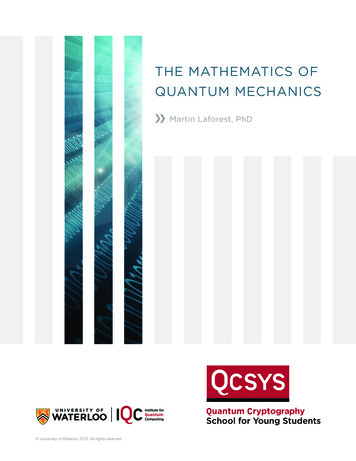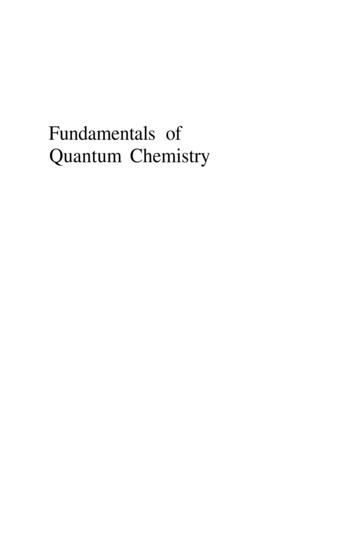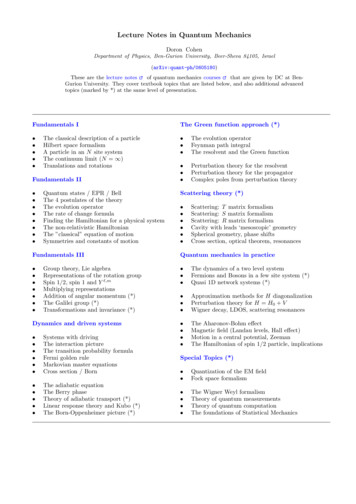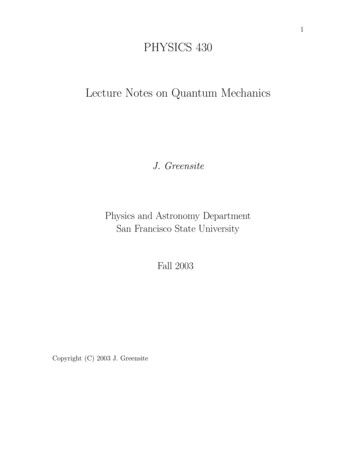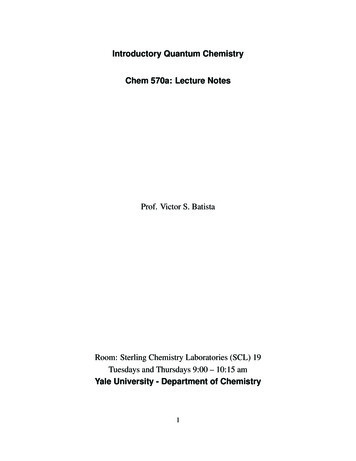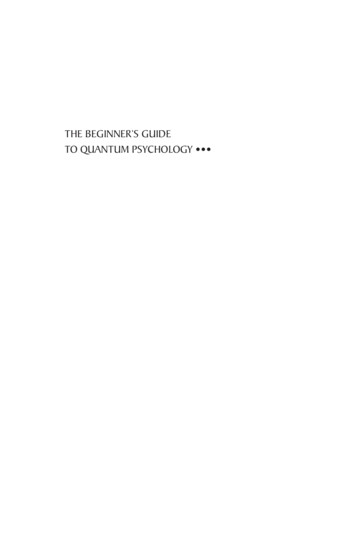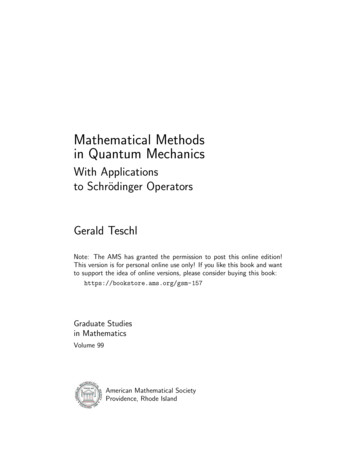
Transcription
Mathematical Methodsin Quantum MechanicsWith Applicationsto Schrödinger OperatorsGerald TeschlNote: The AMS has granted the permission to post this online edition!This version is for personal online use only! If you like this book and wantto support the idea of online versions, please consider buying this book:https://bookstore.ams.org/gsm-157Graduate Studiesin MathematicsVolume 99American Mathematical SocietyProvidence, Rhode Island
Editorial BoardDavid Cox (Chair)Steven G. KrantsRafe MazzeoMartin Scharlemann2000 Mathematics subject classification. 81-01, 81Qxx, 46-01, 34Bxx, 47B25Abstract. This book provides a self-contained introduction to mathematical methods in quantum mechanics (spectral theory) with applications to Schrödinger operators. The first part covers mathematical foundations of quantum mechanics from self-adjointness, the spectral theorem,quantum dynamics (including Stone’s and the RAGE theorem) to perturbation theory for selfadjoint operators.The second part starts with a detailed study of the free Schrödinger operator respectivelyposition, momentum and angular momentum operators. Then we develop Weyl–Titchmarsh theory for Sturm–Liouville operators and apply it to spherically symmetric problems, in particularto the hydrogen atom. Next we investigate self-adjointness of atomic Schrödinger operators andtheir essential spectrum, in particular the HVZ theorem. Finally we have a look at scatteringtheory and prove asymptotic completeness in the short range case.For additional information and updates on this book, visit:http://www.ams.org/bookpages/gsm-99/Typeset by LATEXand Makeindex. Version: February 12, 2009.Library of Congress Cataloging-in-Publication DataTeschl, Gerald, 1970–Mathematical methods in quantum mechanics : with applications to Schrödinger operators/ Gerald Teschl.p. cm. — (Graduate Studies in Mathematics ; v. 99)Includes bibliographical references and index.ISBN 978-0-8218-4660-5 (alk. paper)1. Schrödinger operators. 2. Quantum theory—Mathematics. I. Title.QC174.17.S3T47 20092008045437515’.724–dc22Copying and reprinting. Individual readers of this publication, and nonprofit libraries actingfor them, are permitted to make fair use of the material, such as to copy a chapter for usein teaching or research. Permission is granted to quote brief passages from this publication inreviews, provided the customary acknowledgement of the source is given.Republication, systematic copying, or multiple reproduction of any material in this publication (including abstracts) is permitted only under license from the American MathematicalSociety. Requests for such permissions should be addressed to the Assistant to the Publisher,American Mathematical Society, P.O. Box 6248, Providence, Rhode Island 02940-6248. Requestscan also be made by e-mail to reprint-permission@ams.org.c 2009 by the American Mathematical Society. All rights reserved.The American Mathematical Society retains all rightsexcept those granted too the United States Government.
To Susanne, Simon, and Jakob
ContentsPrefacexiPart 0. PreliminariesChapter 0.A first look at Banach and Hilbert spaces3§0.1.Warm up: Metric and topological spaces§0.2.The Banach space of continuous functions12§0.3.The geometry of Hilbert spaces16§0.4.Completeness22§0.5.Bounded operators22Lp§0.6.Lebesgue§0.7.Appendix: The uniform boundedness principlespaces32532Part 1. Mathematical Foundations of Quantum MechanicsChapter 1.Hilbert spaces37§1.1.Hilbert spaces37§1.2.Orthonormal bases39§1.3.The projection theorem and the Riesz lemma43§1.4.Orthogonal sums and tensor products45C §1.5.The§1.6.Weak and strong convergence49§1.7.Appendix: The Stone–Weierstraß theorem51Chapter 2.algebra of bounded linear operatorsSelf-adjointness and spectrum4755vii
entsSome quantum mechanicsSelf-adjoint operatorsQuadratic forms and the Friedrichs extensionResolvents and spectraOrthogonal sums of operatorsSelf-adjoint extensionsAppendix: Absolutely continuous 3.4.3. The spectral theoremThe spectral theoremMore on Borel measuresSpectral typesAppendix: The Herglotz §4.5.4. Applications of the spectral theoremIntegral formulasCommuting operatorsThe min-max theoremEstimating eigenspacesTensor products of 3.5. Quantum dynamicsThe time evolution and Stone’s theoremThe RAGE theoremThe Trotter product §6.5.§6.6.6. Perturbation theory for self-adjoint operatorsRelatively bounded operators and the Kato–Rellich theoremMore on compact operatorsHilbert–Schmidt and trace class operatorsRelatively compact operators and Weyl’s theoremRelatively form bounded operators and the KLMN theoremStrong and norm resolvent convergence133133136139145149153Part 2. Schrödinger OperatorsChapter 7. The free Schrödinger operator§7.1. The Fourier transform§7.2. The free Schrödinger operator161161167
Contents§7.3.§7.4.ixThe time evolution in the free caseThe resolvent and Green’s function169171Chapter§8.1.§8.2.§8.3.§8.4.8. Algebraic methodsPosition and momentumAngular momentumThe harmonic oscillatorAbstract .§9.4.§9.5.§9.6.§9.7.9. One-dimensional Schrödinger operatorsSturm–Liouville operatorsWeyl’s limit circle, limit point alternativeSpectral transformations IInverse spectral theoryAbsolutely continuous spectrumSpectral transformations IIThe spectra of one-dimensional Schrödinger operators181181187195202206209214Chapter 10. One-particle Schrödinger operators§10.1. Self-adjointness and spectrum§10.2. The hydrogen atom§10.3. Angular momentum§10.4. The eigenvalues of the hydrogen atom§10.5. Nondegeneracy of the ground state221221222225229235Chapter 11. Atomic Schrödinger operators§11.1. Self-adjointness§11.2. The HVZ theorem239239242Chapter 12. Scattering theory§12.1. Abstract theory§12.2. Incoming and outgoing states§12.3. Schrödinger operators with short range potentials247247250253Part 3. AppendixAppendix A. Almost everything about Lebesgue integration§A.1. Borel measures in a nut shell§A.2. Extending a premeasure to a measure§A.3. Measurable functions259259263268
xContents§A.4.The Lebesgue integral270§A.5.Product measures275§A.6.Vague convergence of measures278§A.7.Decomposition of measures280§A.8.Derivatives of measures282Bibliographical notes289Bibliography293Glossary of notation297Index301
PrefaceOverviewThe present text was written for my course Schrödinger Operators heldat the University of Vienna in winter 1999, summer 2002, summer 2005,and winter 2007. It gives a brief but rather self-contained introductionto the mathematical methods of quantum mechanics with a view towardsapplications to Schrödinger operators. The applications presented are highlyselective and many important and interesting items are not touched upon.Part 1 is a stripped down introduction to spectral theory of unboundedoperators where I try to introduce only those topics which are needed forthe applications later on. This has the advantage that you will (hopefully)not get drowned in results which are never used again before you get tothe applications. In particular, I am not trying to present an encyclopedicreference. Nevertheless I still feel that the first part should provide a solidbackground covering many important results which are usually taken forgranted in more advanced books and research papers.My approach is built around the spectral theorem as the central object.Hence I try to get to it as quickly as possible. Moreover, I do not take thedetour over bounded operators but I go straight for the unbounded case.In addition, existence of spectral measures is established via the Herglotztheorem rather than the Riesz representation theorem since this approachpaves the way for an investigation of spectral types via boundary values ofthe resolvent as the spectral parameter approaches the real line.xi
xiiPrefacePart 2 starts with the free Schrödinger equation and computes thefree resolvent and time evolution. In addition, I discuss position, momentum, and angular momentum operators via algebraic methods. This isusually found in any physics textbook on quantum mechanics, with theonly difference that I include some technical details which are typicallynot found there. Then there is an introduction to one-dimensional models (Sturm–Liouville operators) including generalized eigenfunction expansions (Weyl–Titchmarsh theory) and subordinacy theory from Gilbert andPearson. These results are applied to compute the spectrum of the hydrogen atom, where again I try to provide some mathematical details notfound in physics textbooks. Further topics are nondegeneracy of the groundstate, spectra of atoms (the HVZ theorem), and scattering theory (the Enßmethod).PrerequisitesI assume some previous experience with Hilbert spaces and boundedlinear operators which should be covered in any basic course on functionalanalysis. However, while this assumption is reasonable for mathematicsstudents, it might not always be for physics students. For this reason thereis a preliminary chapter reviewing all necessary results (including proofs).In addition, there is an appendix (again with proofs) providing all necessaryresults from measure theory.LiteratureThe present book is highly influenced by the four volumes of Reed andSimon [40]–[43] (see also [14]) and by the book by Weidmann [60] (anextended version of which has recently appeared in two volumes [62], [63],however, only in German). Other books with a similar scope are for example[14], [15], [21], [23], [39], [48], and [55]. For those who want to know moreabout the physical aspects, I can recommend the classical book by Thirring[58] and the visual guides by Thaller [56], [57]. Further information can befound in the bibliographical notes at the end.Reader’s guideThere is some intentional overlap between Chapter 0, Chapter 1, andChapter 2. Hence, provided you have the necessary background, you canstart reading in Chapter 1 or even Chapter 2. Chapters 2 and 3 are key
Prefacexiiichapters and you should study them in detail (except for Section 2.6 whichcan be skipped on first reading). Chapter 4 should give you an idea of howthe spectral theorem is used. You should have a look at (e.g.) the firstsection and you can come back to the remaining ones as needed. Chapter 5contains two key results from quantum dynamics: Stone’s theorem and theRAGE theorem. In particular the RAGE theorem shows the connectionsbetween long time behavior and spectral types. Finally, Chapter 6 is againof central importance and should be studied in detail.The chapters in the second part are mostly independent of each otherexcept for Chapter 7, which is a prerequisite for all others except for Chapter 9.If you are interested in one-dimensional models (Sturm–Liouville equations), Chapter 9 is all you need.If you are interested in atoms, read Chapter 7, Chapter 10, and Chapter 11. In particular, you can skip the separation of variables (Sections 10.3and 10.4, which require Chapter 9) method for computing the eigenvalues ofthe hydrogen atom, if you are happy with the fact that there are countablymany which accumulate at the bottom of the continuous spectrum.If you are interested in scattering theory, read Chapter 7, the first twosections of Chapter 10, and Chapter 12. Chapter 5 is one of the key prerequisites in this case.UpdatesThe AMS is hosting a web page for this book athttp://www.ams.org/bookpages/gsm-99/where updates, corrections, and other material may be found, including alink to material on my own web site:http://www.mat.univie.ac.at/ gerald/ftp/book-schroe/AcknowledgmentsI would like to thank Volker Enß for making his lecture notes [18] available to me. Many colleagues and students have made useful suggestions andpointed out mistakes in earlier drafts of this book, in particular: KerstinAmmann, Jörg Arnberger, Chris Davis, Fritz Gesztesy, Maria HoffmannOstenhof, Zhenyou Huang, Helge Krüger, Katrin Grunert, Wang Lanning,Daniel Lenz, Christine Pfeuffer, Roland Möws, Arnold L. Neidhardt, Harald
xivPrefaceRindler, Johannes Temme, Karl Unterkofler, Joachim Weidmann, and RudiWeikard.If you also find an error or if you have comments or suggestions(no matter how small), please let me know.I have been supported by the Austrian Science Fund (FWF) during muchof this writing, most recently under grant Y330.Gerald TeschlVienna, AustriaJanuary 2009Gerald TeschlFakultät für MathematikNordbergstraße 15Universität Wien1090 Wien, AustriaE-mail: Gerald.Teschl@univie.ac.atURL: http://www.mat.univie.ac.at/ gerald/
Part 0Preliminaries
Chapter 0A first look at Banachand Hilbert spacesI assume that the reader has some basic familiarity with measure theory and functional analysis. For convenience, some facts needed from Banach and Lp spaces arereviewed in this chapter. A crash course in measure theory can be found in theAppendix A. If you feel comfortable with terms like Lebesgue Lp spaces, Banachspace, or bounded linear operator, you can skip this entire chapter. However, youmight want to at least browse through it to refresh your memory.0.1. Warm up: Metric and topological spacesBefore we begin, I want to recall some basic facts from metric and topologicalspaces. I presume that you are familiar with these topics from your calculuscourse. As a general reference I can warmly recommend Kelly’s classicalbook [26].A metric space is a space X together with a distance function d :X X R such that(i) d(x, y) 0,(ii) d(x, y) 0 if and only if x y,(iii) d(x, y) d(y, x),(iv) d(x, z) d(x, y) d(y, z) (triangle inequality).If (ii) does not hold, d is called a semi-metric. Moreover, it is straightforward to see the inverse triangle inequality (Problem 0.1) d(x, y) d(z, y) d(x, z).(0.1)3
40. A first look at Banach and Hilbert spacesPExample. Euclidean space Rn together with d(x, y) ( nk 1 (xk yk )2 )1/2Pis a metric space and so is Cn together with d(x, y) ( nk 1 xk yk 2 )1/2 . The setBr (x) {y X d(x, y) r}(0.2)is called an open ball around x with radius r 0. A point x of some setU is called an interior point of U if U contains some ball around x. If x isan interior point of U , then U is also called a neighborhood of x. A pointx is called a limit point of U if (Br (x)\{x}) U 6 for every ball aroundx. Note that a limit point x need not lie in U , but U must contain pointsarbitrarily close to x.Example. Consider R with the usual metric and let U ( 1, 1). Thenevery point x U is an interior point of U . The points 1 are limit pointsof U . A set consisting only of interior points is called open. The family ofopen sets O satisfies the properties(i) , X O,(ii) O1 , O2 O implies O1 O2 O,S(iii) {Oα } O implies α Oα O.That is, O is closed under finite intersections and arbitrary unions.In general, a space X together with a family of sets O, the open sets,satisfying (i)–(iii) is called a topological space. The notions of interiorpoint, limit point, and neighborhood carry over to topological spaces if wereplace open ball by open set.There are usually different choices for the topology. Two usually notvery interesting examples are the trivial topology O { , X} and thediscrete topology O P(X) (the powerset of X). Given two topologiesO1 and O2 on X, O1 is called weaker (or coarser) than O2 if and only ifO1 O2 .Example. Note that different metrics can give rise to the same topology.For example, we can equip Rn (or Cn ) with the Euclidean distance d(x, y)as before or we could also usenX d(x, y) xk yk .(0.3)k 1Thenvu nnnXuX1 X xk t xk 2 xk nk 1k 1k 1(0.4)
0.1. Warm up: Metric and topological spaces5shows Br/ n (x) B̃r (x) Br (x), where B, B̃ are balls computed using d, respectively.d, Example. We can always replace a metric d by the bounded metric y) d(x, y)d(x,(0.5)1 d(x, y)without changing the topology. Every subspace Y of a topological space X becomes a topological spaceof its own if we call O Y open if there is some open set Õ X such thatO Õ Y (induced topology).Example. The set (0, 1] R is not open in the topology of X R, but it isopen in the induced topology when considered as a subset of Y [ 1, 1]. A family of open sets B O is called a base for the topology if for eachx and each neighborhood U (x), there is some set O B with x O U (x).Since an open setS O is a neighborhood of every one of its points, it can bewritten as O O Õ B Õ and we haveLemma 0.1. If B O is a base for the topology, then every open set canbe written as a union of elements from B.If there exists a countable base, then X is called second countable.Example. By construction the open balls B1/n (x) are a base for the topology in a metric space. In the case of Rn (or Cn ) it even suffices to take ballswith rational center and hence Rn (and Cn ) is second countable. A topological space is called a Hausdorff space if for two differentpoints there are always two disjoint neighborhoods.Example. Any metric space is a Hausdorff space: Given two differentpoints x and y, the balls Bd/2 (x) and Bd/2 (y), where d d(x, y) 0, aredisjoint neighborhoods (a semi-metric space will not be Hausdorff). The complement of an open set is called a closed set. It follows fromde Morgan’s rules that the family of closed sets C satisfies(i) , X C,(ii) C1 , C2 C implies C1 C2 C,T(iii) {Cα } C implies α Cα C.That is, closed sets are closed under finite unions and arbitrary intersections.The smallest closed set containing a given set U is called the closure\U C,(0.6)C C,U C
60. A first look at Banach and Hilbert spacesand the largest open set contained in a given set U is called the interior[U O.(0.7)O O,O UWe can define interior and limit points as before by replacing the wordball by open set. Then it is straightforward to checkLemma 0.2. Let X be a topological space. Then the interior of U is theset of all interior points of U and the closure of U is the union of U withall limit points of U .A sequence (xn ) n 1 X is said to converge to some point x X ifd(x, xn ) 0. We write limn xn x as usual in this case. Clearly thelimit is unique if it exists (this is not true for a semi-metric).Every convergent sequence is a Cauchy sequence; that is, for everyε 0 there is some N N such thatd(xn , xm ) ε,n, m N.(0.8)If the converse is also true, that is, if every Cauchy sequence has a limit,then X is called complete.Example. Both Rn and Cn are complete metric spaces. A point x is clearly a limit point of U if and only if there is some sequencexn U \{x} converging to x. HenceLemma 0.3. A closed subset of a complete metric space is again a completemetric space.Note that convergence can also be equivalently formulated in terms oftopological terms: A sequence xn converges to x if and only if for everyneighborhood U of x there is some N N such that xn U for n N . Ina Hausdorff space the limit is unique.A set U is called dense if its closure is all of X, that is, if U X. Ametric space is called separable if it contains a countable dense set. Notethat X is separable if and only if it is second countable as a topologicalspace.Lemma 0.4. Let X be a separable metric space. Every subset of X is againseparable.Proof. Let A {xn }n N be a dense set in X. The only problem is thatA Y might contain no elements at all. However, some elements of A mustbe at least arbitrarily close: Let J N2 be the set of all pairs (n, m) forwhich B1/m (xn ) Y 6 and choose some yn,m B1/m (xn ) Y for all(n, m) J. Then B {yn,m }(n,m) J Y is countable. To see that B is
0.1. Warm up: Metric and topological spaces7dense, choose y Y . Then there is some sequence xnk with d(xnk , y) 1/k.Hence (nk , k) J and d(ynk ,k , y) d(ynk ,k , xnk ) d(xnk , y) 2/k 0. A function between metric spaces X and Y is called continuous at apoint x X if for every ε 0 we can find a δ 0 such thatdY (f (x), f (y)) εifdX (x, y) δ.(0.9)If f is continuous at every point, it is called continuous.Lemma 0.5. Let X, Y be metric spaces and f : X Y . The following areequivalent:(i) f is continuous at x (i.e, (0.9) holds).(ii) f (xn ) f (x) whenever xn x.(iii) For every neighborhood V of f (x), f 1 (V ) is a neighborhood of x.Proof. (i) (ii) is obvious. (ii) (iii): If (iii) does not hold, there isa neighborhood V of f (x) such that Bδ (x) 6 f 1 (V ) for every δ. Hencewe can choose a sequence xn B1/n (x) such that f (xn ) 6 f 1 (V ). Thusxn x but f (xn ) 6 f (x). (iii) (i): Choose V Bε (f (x)) and observethat by (iii), Bδ (x) f 1 (V ) for some δ. The last item implies that f is continuous if and only if the inverse imageof every open (closed) set is again open (closed).Note: In a topological space, (iii) is used as the definition for continuity.However, in general (ii) and (iii) will no longer be equivalent unless one usesgeneralized sequences, so-called nets, where the index set N is replaced byarbitrary directed sets.The support of a function f : X Cn is the closure of all points x forwhich f (x) does not vanish; that is,supp(f ) {x X f (x) 6 0}.(0.10)If X and Y are metric spaces, then X Y together withd((x1 , y1 ), (x2 , y2 )) dX (x1 , x2 ) dY (y1 , y2 )(0.11)is a metric space. A sequence (xn , yn ) converges to (x, y) if and only ifxn x and yn y. In particular, the projections onto the first (x, y) 7 x,respectively, onto the second (x, y) 7 y, coordinate are continuous.In particular, by the inverse triangle inequality (0.1), d(xn , yn ) d(x, y) d(xn , x) d(yn , y),we see that d : X X R is continuous.(0.12)
80. A first look at Banach and Hilbert spacesExample. If we consider R R, we do not get the Euclidean distance ofR2 unless we modify (0.11) as follows:p 1 , y1 ), (x2 , y2 )) dX (x1 , x2 )2 dY (y1 , y2 )2 .d((x(0.13)As noted in our previous example, the topology (and thus also convergence/continuity) is independent of this choice. If X and Y are just topological spaces, the product topology is definedby calling O X Y open if for every point (x, y) O there are openneighborhoods U of x and V of y such that U V O. In the case ofmetric spaces this clearly agrees with the topology defined via the productmetric (0.11).SA cover of a set Y X is a family of sets {Uα } such that Y α Uα .A cover is called open if all Uα are open. Any subset of {Uα } which stillcovers Y is called a subcover.Lemma 0.6 (Lindelöf). If X is second countable, then every open coverhas a countable subcover.Proof. Let {Uα } be an open cover for Y and let B be a countable base.Since every Uα can be written as a union of elements from B, the set of allB B which satisfy B Uα for some α form a countable open cover for Y .Moreover, for every Bn in this set we can find an αn such that Bn Uαn .By construction {Uαn } is a countable subcover. A subset K X is called compact if every open cover has a finitesubcover.Lemma 0.7. A topological space is compact if and only if it has the finiteintersection property: The intersection of a family of closed sets is emptyif and only if the intersection of some finite subfamily is empty.Proof. By taking complements, to every family of open sets there is a corresponding family of closed sets and vice versa. Moreover, the open setsare a cover if and only if the corresponding closed sets have empty intersection. A subset K X is called sequentially compact if every sequence hasa convergent subsequence.Lemma 0.8. Let X be a topological space.(i) The continuous image of a compact set is compact.(ii) Every closed subset of a compact set is compact.(iii) If X is Hausdorff, any compact set is closed.
0.1. Warm up: Metric and topological spaces9(iv) The product of finitely many compact sets is compact.(v) A compact set is also sequentially compact.Proof. (i) Observe that if {Oα } is an open cover for f (Y ), then {f 1 (Oα )}is one for Y .(ii) Let {Oα } be an open cover for the closed subset Y . Then {Oα } {X\Y } is an open cover for X.(iii) Let Y X be compact. We show that X\Y is open. Fix x X\Y(if Y X, there is nothing to do). By the definition of Hausdorff, forevery y Y there are disjoint neighborhoods V (y) of y and Uy (x) of x. Bycompactness ofT Y , there are y1 , . . . , yn such that the V (yj ) cover Y . Butthen U (x) nj 1 Uyj (x) is a neighborhood of x which does not intersectY.(iv) Let {Oα } be an open cover for X Y . For every (x, y) X Ythere is some α(x, y) such that (x, y) Oα(x,y) . By definition of the producttopology there is some open rectangle U (x, y) V (x, y) Oα(x,y) . Hence forfixed x, {V (x, y)}y Y is an open cover of Y . Hence there areT finitely manypoints yk (x) such that the V (x, yk (x)) cover Y . Set U (x) k U (x, yk (x)).Since finite intersections of open sets are open, {U (x)}x X is an open coverand there are finitely many points xj such that the U (xj ) cover X. Byconstruction, the U (xj ) V (xj , yk (xj )) Oα(xj ,yk (xj )) cover X Y .(v) Let xn be a sequence which has no convergent subsequence. ThenK {xn } has no limit points and is hence compact by (ii). For every nthere is a ball Bεn (xn ) which contains only finitely many elements of K.However, finitely many suffice to cover K, a contradiction. In a metric space compact and sequentially compact are equivalent.Lemma 0.9. Let X be a metric space. Then a subset is compact if and onlyif it is sequentially compact.Proof. By item (v) of the previous lemma it suffices to show that X iscompact if it is sequentially compact.First of all note that every cover of open balls with fixed radius ε 0has a finitesubcover since if this were false we could construct a sequenceSn 1xn X\ m 1 Bε (xm ) such that d(xn , xm ) ε for m n.In particular, we are done if we can show that for every open cover{Oα } there is some ε 0 such that for every x we have Bε (x) Oα forsome α α(x). Indeed, choosing {xk }nk 1 such that Bε (xk ) is a cover, wehave that Oα(xk ) is a cover as well.So it remains to show that there is such an ε. If there were none, forevery ε 0 there must be an x such that Bε (x) 6 Oα for every α. Choose
100. A first look at Banach and Hilbert spacesε n1 and pick a corresponding xn . Since X is sequentially compact, it is norestriction to assume xn converges (after maybe passing to a subsequence).Let x lim xn . Then x lies in some Oα and hence Bε (x) Oα . But choosingn so large that n1 2ε and d(xn , x) 2ε , we have B1/n (xn ) Bε (x) Oα ,contradicting our assumption. Please also recall the Heine–Borel theorem:Theorem 0.10 (Heine–Borel). In Rn (or Cn ) a set is compact if and onlyif it is bounded and closed.Proof. By Lemma 0.8 (ii) and (iii) it suffices to show that a closed intervalin I R is compact. Moreover, by Lemma 0.9 it suffices to show thatevery sequence in I [a, b] has a convergent subsequence. Let xn be oura bsequence and divide I [a, a b2 ] [ 2 , b]. Then at least one of these twointervals, call it I1 , contains infinitely many elements of our sequence. Lety1 xn1 be the first one. Subdivide I1 and pick y2 xn2 , with n2 n1 asbefore. Proceeding like this, we obtain a Cauchy sequence yn (note that by construction In 1 In and hence yn ym b an for m n).A topological space is called locally compact if every point has a compact neighborhood.Example. Rn is locally compact. The distance between a point x X and a subset Y X isdist(x, Y ) inf d(x, y).y Y(0.14)Note that x is a limit point of Y if and only if dist(x, Y ) 0.Lemma 0.11. Let X be a metric space. Then dist(x, Y ) dist(z, Y ) d(x, z).(0.15)In particular, x 7 dist(x, Y ) is continuous.Proof. Taking the infimum in the triangle inequality d(x, y) d(x, z) d(z, y) shows dist(x, Y ) d(x, z) dist(z, Y ). Hence dist(x, Y ) dist(z, Y ) d(x, z). Interchanging x and z shows dist(z, Y ) dist(x, Y ) d(x, z). Lemma 0.12 (Urysohn). Suppose C1 and C2 are disjoint closed subsets ofa metric space X. Then there is a continuous function f : X [0, 1] suchthat f is zero on C1 and one on C2 .If X is locally compact and C1 is compact, one can choose f with compactsupport.
0.1. Warm up: Metric and topological spacesProof. To prove the first claim, set f (x) 11dist(x,C2 )dist(x,C1 ) dist(x,C2 ) .For thesecond claim, observe that there is an open set O such that O is compactand C1 O O X\C2 . In fact, for every x, there is a ball Bε (x) suchthat Bε (x) is compact and Bε (x) X\C2 . Since C1 is compact, finitelymany of them cover C1 and we can choose the union of those balls to be O. Now replace C2 by X\O.Note that Urysohn’s lemma implies that a metric space is normal; thatis, for any two disjoint closed sets C1 and C2 , there are disjoint open setsO1 and O2 such that Cj Oj , j 1, 2. In fact, choose f as in Urysohn’slemma and set O1 f 1 ([0, 1/2)), respectively, O2 f 1 ((1/2, 1]).Lemma 0.13. Let X be a locally compact metric space. Suppose K isa compact set and {Oj }nj 1 an open cover. Then there is a partition ofunity for K subordinate to this cover; that is, there are continuous functionshj : X [0, 1] such that hj has compact support contained in Oj andnXhj (x) 1(0.16)j 1with equality for x K.Proof. For every x K there is some ε and some j such that Bε (x) Oj .By compactness of K, finitely many of these balls cover K. Let Kj be theunion of those balls which lie inside Oj . By Urysohn’s lemma there arefunctions gj : X [0, 1] such that gj 1 on Kj and gj 0 on X\Oj . Nowsetj 1Yhj gj(1 gk ).(0.17)k 1Then hj : X [0, 1] has compact support contained in Oj andnXhj (x) 1 j 1nY(1 gj (x))(0.18)j 1shows that the sum is one for x K, since x Kj for some j impliesgj (x) 1 and causes the product to vanish. Problem 0.1. Show that d(x, y)
2000 Mathematics subject classi cation. 81-01, 81Qxx, 46-01, 34Bxx, 47B25 Abstract. This book provides a self-contained introduction to mathematical methods in quan-tum mechanics (spectral theory) with


